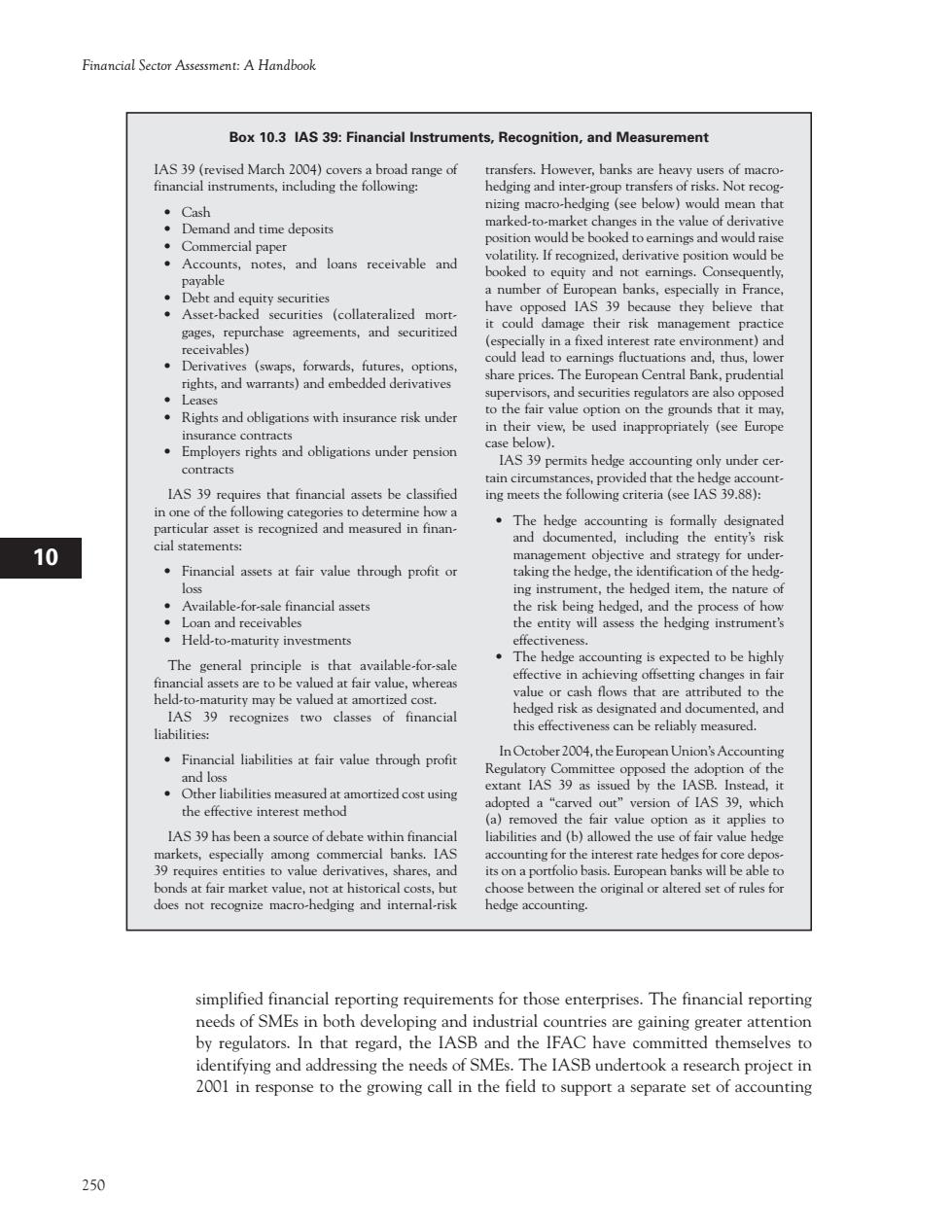正在加载图片...

Financial Sector Assesment:A Handbook Box 10.3 IAS 39:Financial Instruments,Recognition,and Measurement ,banks are heavy of macro owing: ging and ine ges in the Ac and loan revable and equently. w : Employers rihts and obligations under pension contracts 10 .Financial assets at fair value through profit o naseentobiectireandtategyfornde loss ing instrument,the hedged item,the nature of Avabie-for-enc Held-to-maturity investments he itnotiedcos cial liabilities d Financial liabilities at fair ,the European Unions on of mortized cost using s it AS 39 has be ()allowed the of fair value derivatives,shares,an ging an simplified financial nd indus hat the sp themselves to identifying and addressing the needs of SMEs The IASB undertook a research project in 2001 in response to the growing call in the field to support a separate set of accounting 250 250 Financial Sector Assessment: A Handbook 1 I H G F E D C B A 12 11 10 9 8 7 6 5 4 3 2 simplified financial reporting requirements for those enterprises. The financial reporting needs of SMEs in both developing and industrial countries are gaining greater attention by regulators. In that regard, the IASB and the IFAC have committed themselves to identifying and addressing the needs of SMEs. The IASB undertook a research project in 2001 in response to the growing call in the field to support a separate set of accounting Box 10.3 IAS 39: Financial Instruments, Recognition, and Measurement IAS 39 (revised March 2004) covers a broad range of financial instruments, including the following: • Cash • Demand and time deposits • Commercial paper • Accounts, notes, and loans receivable and payable • Debt and equity securities • Asset-backed securities (collateralized mortgages, repurchase agreements, and securitized receivables) • Derivatives (swaps, forwards, futures, options, rights, and warrants) and embedded derivatives • Leases • Rights and obligations with insurance risk under insurance contracts • Employers rights and obligations under pension contracts IAS 39 requires that financial assets be classified in one of the following categories to determine how a particular asset is recognized and measured in financial statements: • Financial assets at fair value through profit or loss • Available-for-sale financial assets • Loan and receivables • Held-to-maturity investments The general principle is that available-for-sale financial assets are to be valued at fair value, whereas held-to-maturity may be valued at amortized cost. IAS 39 recognizes two classes of financial liabilities: • Financial liabilities at fair value through profit and loss • Other liabilities measured at amortized cost using the effective interest method IAS 39 has been a source of debate within financial markets, especially among commercial banks. IAS 39 requires entities to value derivatives, shares, and bonds at fair market value, not at historical costs, but does not recognize macro-hedging and internal-risk transfers. However, banks are heavy users of macrohedging and inter-group transfers of risks. Not recognizing macro-hedging (see below) would mean that marked-to-market changes in the value of derivative position would be booked to earnings and would raise volatility. If recognized, derivative position would be booked to equity and not earnings. Consequently, a number of European banks, especially in France, have opposed IAS 39 because they believe that it could damage their risk management practice (especially in a fixed interest rate environment) and could lead to earnings fluctuations and, thus, lower share prices. The European Central Bank, prudential supervisors, and securities regulators are also opposed to the fair value option on the grounds that it may, in their view, be used inappropriately (see Europe case below). IAS 39 permits hedge accounting only under certain circumstances, provided that the hedge accounting meets the following criteria (see IAS 39.88): • The hedge accounting is formally designated and documented, including the entity’s risk management objective and strategy for undertaking the hedge, the identification of the hedging instrument, the hedged item, the nature of the risk being hedged, and the process of how the entity will assess the hedging instrument’s effectiveness. • The hedge accounting is expected to be highly effective in achieving offsetting changes in fair value or cash flows that are attributed to the hedged risk as designated and documented, and this effectiveness can be reliably measured. In October 2004, the European Union’s Accounting Regulatory Committee opposed the adoption of the extant IAS 39 as issued by the IASB. Instead, it adopted a “carved out” version of IAS 39, which (a) removed the fair value option as it applies to liabilities and (b) allowed the use of fair value hedge accounting for the interest rate hedges for core deposits on a portfolio basis. European banks will be able to choose between the original or altered set of rules for hedge accounting